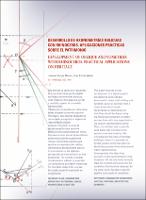Please use this identifier to cite or link to this item:
https://repositorio.usj.es/handle/123456789/889
| Title: | Desarrollo de axonometrías oblicuas con Rhinoceros. Aplicaciones prácticas sobre el patrimonio |
| Other Titles: | Development of oblique axonometries with rhinoceros. Practical applications on heritage |
| Authors: | Estepa Rubio, Antonio

Estepa Rubio, Jesús 
|
| Keywords: | Axonometría; Rhinoceros; Patrimonio; Dibujo; Arquitectura; Geometría; Axonometry; Heritage; Drawing; Architecture; Geometry |
| Issue Date: | 22-Nov-2022 |
| Publisher: | Universitat Politècnica de València |
| Citation: | Estepa Rubio, A. y Estepa Rubio, J. (2022) «Desarrollo de axonometrías oblicuas con Rhinoceros. Aplicaciones prácticas sobre el patrimonio», EGA Expresión Gráfica Arquitectónica, 27(46), pp. 60–73. doi: 10.4995/ega.2022.18461. |
| Abstract: | Este artículo se centra en el desarrollo de un procedimiento gráfico digital para trazar axonometrías oblicuas, tanto militares como egipcias, aéreas o cenitales, a partir de un modelo tridimensional. Planteamos una explicación sobre cómo deben dibujarse usando el programa Rhinoceros, para obtener perspectivas con verdadera magnitud en el plano de representación elegido. Después, trataremos un caso de estudio específico que permitirá demostrar el funcionamiento del mismo. Representaremos el caso de los edificios patrimoniales donde es pertinente manejar herramientas gráficas que permitan una aproximación métrica tridimensional absolutamente precisa. En consecuencia, los objetivos perseguidos se concentrarán en dos situaciones. Por un lado, enunciar formalmente el método y transcribir las condiciones que deben imponerse. Por otro lado, desarrollar un caso de estudio específico aplicado de complejidad. |
| Description: | This paper focuses on the development of a digital graphic procedure to draw oblique axonometric views, both military and Egyptian, aerial or zenithal, from a three-dimensional model. We propose an explanation on how they should be drawn using the Rhinoceros program, to obtain perspectives with true magnitude in the chosen representation plane. Then, we will deal with a specific case study that will allow us to demonstrate how it works. We will represent the case of heritage buildings where it is pertinent to handle graphic tools that allow an absolutely precise three-dimensional metric approximation. Consequently, the objectives pursued will be concentrated in two situations. On the one hand, formally state the method and transcribe the conditions that must be imposed. On the other hand, develop a specific applied case study of complexity. |
| URI: | https://repositorio.usj.es/handle/123456789/889 |
| ISSN: | 2254-6103 |
| Appears in Collections: | Artículos de revistas |
Files in This Item:
| File | Description | Size | Format | |
|---|---|---|---|---|
| Desarrollo de axonometrías oblicuas con rhinoceros.pdf | 1,43 MB | Adobe PDF |  View/Open |
This item is licensed under a Creative Commons License

